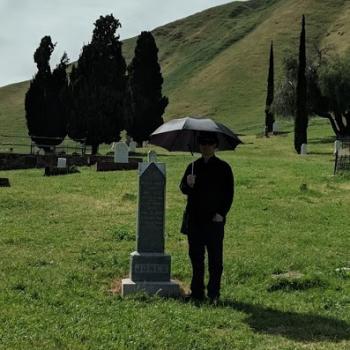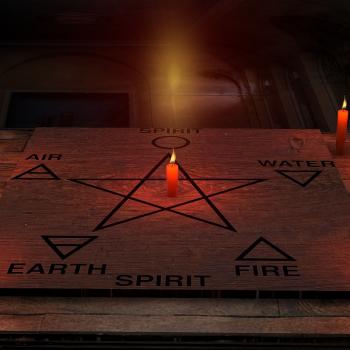After two solid years of daily practice, I have good news. Like so many other things, it gets easier with time.
For the past 734 days, I have performed the Lesser Banishing Ritual of the Pentagram (LBRP) on a daily basis. For 584 days, I have been doing spirit-cleansing exercises. And 579 days ago I added some qigong-lite. My wife and I are 245 days into a new meditation regimen under a teacher.
There is no magical formula that will make daily practice actually easy. Like everyone else on every path of self-cultivation, we each must put in the work for ourselves.
You might find yourself climbing the Witch’s Pyramid, gathering your resources to Cross the Abyss, or simply wandering the desert for forty days. The path forward might take you anywhere.

Photo by Hajor, via Wikimedia Commons
But no matter where it leads, there are certain commonalities to all our experiences. Knowing the path will be hard can be intimidating. Understanding why it is hard can make all the difference in successfully creating and sustaining a daily practice.
The Story Thus Far
Back in January 2016, I was diagnosed with blood cancer. The treatments were spectacular science fiction, involving two hospitals, an anonymous stem-cell donor, and the most loyal and loving wife on the planet. With the help of more than a dozen hardcore practitioners and thousands of prayers, I gathered the strength to pull through.(1)
I was given innumerable treatments where I would look at it and ask “won’t that have bad long-term effects?“ To which the doctors invariably responded with some version of “if you have long-term effects of any kind, we’ll call it a win.” Survival was hard-won, and left me with a body, mind, and spirit just plain wrecked with both effects and side-effects.
At the time I was no stranger to daily practice. I had, in fact, been at if for a year and a half when the diagnosis came down.
My most recent practice had started in mid-August 2014, when I had begun daily recitation of a targeted translation of the Emerald Tablet of Hermes Trismegistus. I had had to leave off at just over 500 days when I was taken into the hospital.
Fast-forward to July 2016. I was provisionally released into a tiny “apartment” on the hospital campus. The doctors had given me a brand-spanking-new immune system that couldn’t yet hold off much of anything.
My pill regimen included a ton of immunosuppressants so it wouldn’t accidentally take out something important (like, say, my liver). My body was so weak, I could only stand briefly and was in physical therapy to build back even basic muscles.
A friend of mine had collected my basic magical kit from my home and brought it to the hospital. It took me days to gather then energy, but I took my ritual knife and toddled to the only open space in the apartment. Lifting the blade, I began at the beginning.

There were a couple of false starts, but by that September I had settled in to a steady rhythm. Whether I feel like it or not, each day I rally my resources and re-commit to my daily practice.
Three Essentials
Creating a successful daily practice is not easy. The three essential steps are clear purpose, clean space, and committed practice.
We need to prioritize our practice. That does not mean bailing on other meaningful things, but it might mean cutting out some of the fat in our lives to make room.
In order to get started with an effective daily practice, you will need to create a minimal clean space in our environment. As your practice deepens, you may find that the desire to create a clean space will grow as well. External clarity and internal focus often build hand in hand.
In the end, each practitioner must make the commitment. Sometimes that means taking a stand and telling your loved ones that you need regular time for yourself, no questions asked.
Other times it might means employing some cleverness. I once did ten minutes of daily practice in the accessible bathroom in Keflavik Airport because, well, that was my best option.
Daily practice teaches more than consistency. Perseverance means approaching a goal with strength, but also flexibility.
The Reality of Daily Practice
From experience, I can promise that when you start making changes in your life, life will push back. At first, it will win. Persistence is a must.
As you begin to practice consistently, the world will throw challenges and distractions in your way. There are good, solid metaphysical reasons for this, but understanding them is not terribly useful. What is useful is pushing through the obstacles.

When we try to change our lives, we learn that the world does not revolve around us. Once we know that for sure, we can use the world’s resistance for the spiritual equivalent of strength training.
While obstacles seemingly thrown in your path are not lessons that the “universe” is trying to teach you, it can still be useful to think of them that way. Being right is not the point. Consistency and quality of practice is.
You know how, when you start to work out, your muscles ache after a couple of days? The drama that arises to prevent you from continuing your practice is the metaphysical equivalent of those sore muscles.
Yet as much as we need strength, we also need flexibility and resilience. If something truly is not working for you, switch it up. On the other hand, if the tasks you have set are too easy, add a little more weight.
The Value of Daily Practice
It is not uncommon to find people, even magical practitioners, who buy into the idea that magic can and should protect us from life. This is not a unique, or even uniquely Western, belief.
For instance, reading Daoist hagiographies, we can see that there is a general belief that self-cultivation should protect us from all the bad stuff. One of the major goals, for both Western and Daoist alchemies, was to achieve immortality.
Knowing actual practitioners, we cannot help but realize this is not true. I am of the firm belief that spiritual exploration not only fails to protect us from the dangers of the world, but that it in fact exposes us to new and different ones.
The greater worlds of the spirit and the sacred are real. Committing to them means understanding and accepting risks. Power without repercussions is not magic; it is fantasy.
A person who hardly leaves their apartment for fear of danger is unlikely to be hit by a bus. In the same way, someone who takes no spiritual risks probably lives a “safer” life. But it is not a life I would choose to live.
The best way to ameliorate these risks is to commit to daily practice. It will not prevent life from happening, but it can build your spiritual strength, flexibility and resilience to help you face whatever happens.
(1) All life is a holding action. Cancer is lousy, and my particular brand of cancer is worse than average. I’m not remotely out of the woods, yet. One of my realizations from my time on, and occasionally over, the brink of death is that the fight for our lives is not some day in the distant future. It is here and now and always.
















